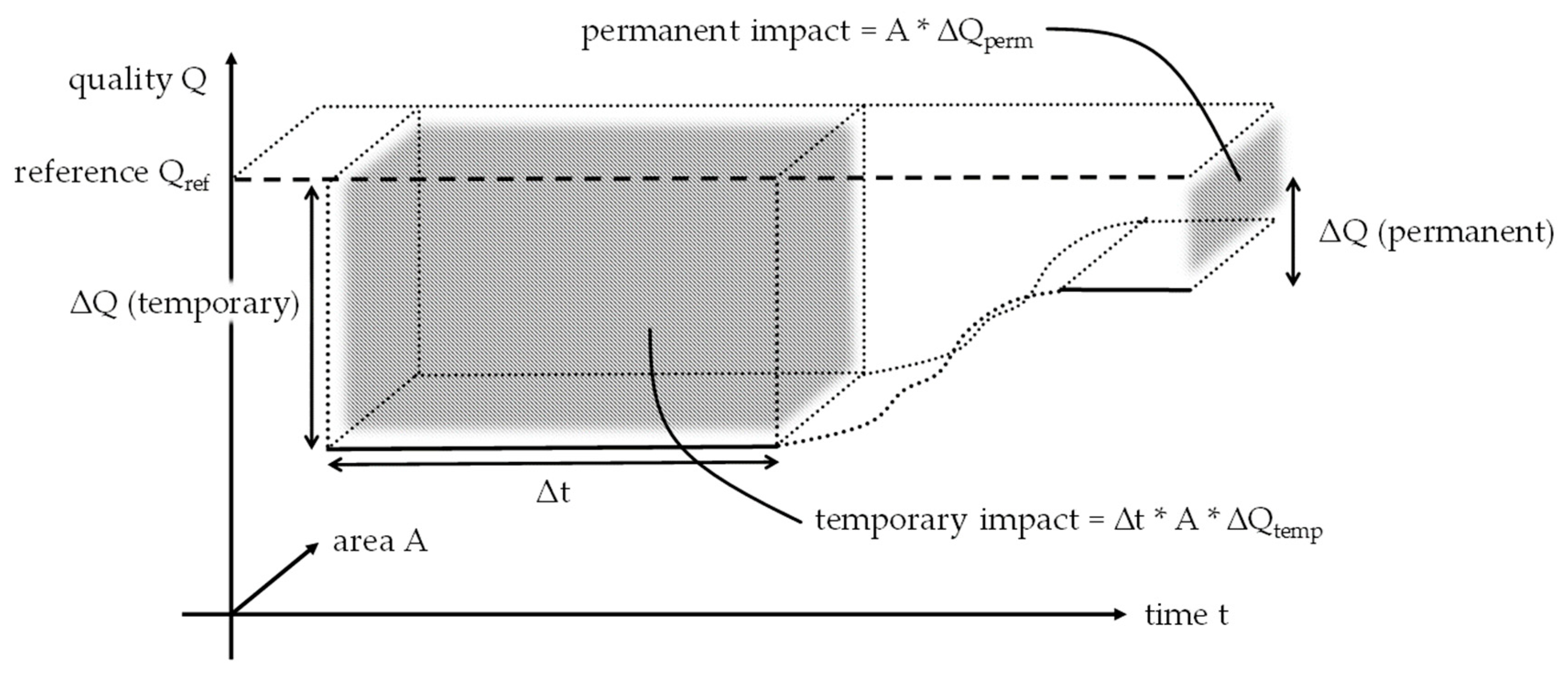Valuing Biodiversity in Life Cycle Impact Assessment
Abstract
1. Introduction
2. Materials and Methods
2.1. Established LCA Principles
2.2. State of the Art in Biodiversity LCIA
2.3. Requirements of Various Stakeholders
- addressees of LCA results, i.e., decision makers that use LCA for decision support;
- everyday LCA practitioners that provide LCA as a service to the addressees;
- the scientific LCA community that develops sub-methods within the LCA framework, to be applied by the practitioners and
- conservationists from whose realm we as LCA developers adopt methods for use within the LCA methodology.
2.3.1. Requirements of LCA Addressees
2.3.2. Requirements of LCA Practitioners
2.3.3. Requirements of the Scientific LCA Community
2.3.4. Requirements of Conservationists
2.4. Research Gaps
3. Proposal for a Biodiversity Impact Assessment Method
3.1. Overall Structure
- Each parameter input x is transformed into a biodiversity value contribution y by means of a biodiversity contribution function y(x).
- One or more biodiversity value contributions (e.g., yA and yB) are aggregated into a criterion z by means of an aggregation function; e.g., zAB (yA, yB).
- Several criteria (e.g., zAB and zCD) are aggregated into the land use-specific biodiversity value BVLU by means of a linear function; e.g., BVLU (zAB, zCD).
- The land use specific biodiversity value BVLU is transformed into the local biodiversity value BVloc by fitting the interval of possible BVLU values into the interval between the minimum and maximum local biodiversity value.
- The local biodiversity value BVloc is transformed into the global biodiversity value BVglo by multiplication with the ecoregion factor EF. This BVglo is the end result, i.e., the Q value for further use in the land use framework.
3.2. Biodiversity Parameters and Their Contributions to the Biodiversity Value
3.3. Biodiversity Criteria
3.4. Global Weighting
4. Example
5. Discussion
5.1. Strengths of the Method
5.2. Weaknesses of the Method
6. Outlook
Supplementary Materials
Author Contributions
Funding
Acknowledgments
Conflicts of Interest
Glossary
| A | Area |
| BVI | Biodiversity Value Increment (unit of the biodiversity quality) |
| BVLU(zAB, zCD) | land use-specific biodiversity value BVLU by means of a linear function of zAB, zCD |
| CBD | UN Convention on Biological Diversity |
| EF | ecoregion factor |
| FU | Functional Unit |
| EIA | Environmental Impact Assessment |
| GEP | Global Extinction Probabilities |
| IUCN | International Union for the Conservation of Nature |
| LCA | Life Cycle Assessment |
| LCIA | Life Cycle Impact Assessment |
| MCDA | multi-criteria decision analysis |
| Q | quality |
| Qref | reference quality level |
| R&D | research and Development |
| SDGs | UN Sustainable Development Goals |
| SGF | area share of grassland and forest |
| SRA | area share of Roadless Areas |
| SW | area share of wetlands |
| t | time |
| t0 | start of a time period |
| tfin | end of a time period |
| zAB | biodiversity value contributions of parameters A and B aggregated to criterion Z |
| ΔQ | quality difference |
| ΔQperm | quality difference (permanent) |
| ΔQtemp | quality difference (temporary) |
| Δt | time period |
References
- United Nations (UN). Convention on Biological Diversity; United Nations Treaty Series; United Nations (UN): Rio de Janeiro, Brazil, 5 June 1992; No. 1760; UNTS 79; 31 ILM 818; Available online: https://www.cbd.int/convention/text/default.shtml (accessed on 24 July 2019).
- Cardinale, B.J.; Duffy, J.E.; Gonzalez, A.; Hooper, D.U.; Perrings, C.; Venail, P.; Naeem, S. Biodiversity loss and its impact on humanity. Nature 2012, 486, 59–67. [Google Scholar] [CrossRef] [PubMed]
- Hautier, Y.; Tilman, D.; Isbell, F.; Seabloom, E.W.; Borer, E.T.; Reich, P.B. Anthropogenic environmental changes affect ecosystem stability via biodiversity. Science 2015, 348, 336–340. [Google Scholar] [CrossRef] [PubMed]
- European Commission. Why do We Need to Protect Biodiversity? European Commission: Brussels, Belgium, 2018; Available online: http://ec.europa.eu/environment/nature/biodiversity/intro/index_en.htm (accessed on 24 July 2019).
- IPBES. Summary for Policymakers of the Global Assessment Report on Biodiversity and Ecosystem Services of the Intergovernmental Science-Policy Platform on Biodiversity and Ecosystem Services; IPBES Secretariat: Bonn, Germany, 2019; Available online: https://www.ipbes.net/news/ipbes-global-assessment-summary-policymakers-pdf (accessed on 24 July 2019).
- Borges, P.A.V.; Gabriel, R.; Fattorini, S. Biodiversity Erosion: Causes and Consequences. In Life on Land. Encyclopedia of the UN Sustainable Development Goals; Leal Filho, W., Azul, A., Brandli, L., Özuyar, P., Wall, T., Eds.; Springer: Cham, Germany, 2019. [Google Scholar]
- United Nations. Sustainable Development Goals. Available online: https://www.un.org/sustainabledevelopment/sustainable-development-goals/ (accessed on 24 July 2019).
- Chaudhary, A.; Verones, F.; de Baan, L.; Hellweg, S. Quantifying Land Use Impacts on Biodiversity: Combining Species—Area Models and Vulnerability Indicators. Environ. Sci. Technol. 2015, 49, 9987–9995. [Google Scholar] [CrossRef] [PubMed]
- Klöpffer, W.; Grahl, B. Life Cycle Assessment; Wiley-VCH: Weinheim, Germany, 2014. [Google Scholar]
- International Organization for Standardization. DIN EN ISO 14040:2009 (2009): Environmental Management-Life Cycle Assessment-Principles and Framework; Beuth: Berlin, Germany, 2009. [Google Scholar]
- International Organization for Standardization. DIN EN ISO 14044:2006 (2006): Environmental Management-Life Cycle Assessment-Requirements and Guidelines; Beuth: Berlin, Germany, 2006. [Google Scholar]
- Hauschild, M.Z.; Rosenbaum, R.K.; Olsen, S.I. Life Cycle Assessment; Hauschild, M.Z., Rosenbaum, R.K., Olsen, S.I., Eds.; Springer: Cham, Germany, 2018. [Google Scholar]
- Guinée, J.B.; Huppes, G.; Lankreijer, R.M.; Udo de Haes, H.A.; Wegener Sleeswijk, A. Environmental Life Cycle Assessment of Products. Guide-October 1992; Heijungs, R., Ed.; Universiteit Leiden: Leiden, The Netherlands, 1992. [Google Scholar]
- I Canals, L.M.; Bauer, C.; Depestele, J.; Dubreuil, A.; Knuchel, R.F.; Gaillard, G.; Michelsen, O.; Müller-Wenk, R.; Rydgren, B. Key Elements in a Framework for Land Use Impact Assessment Within LCA (11 pp). Int. J. Life Cycle Assess. 2007, 12, 5–15. [Google Scholar] [CrossRef]
- Koellner, T.; de Baan, L.; Beck, T.; Brandão, M.; Civit, B.; Margni, M.; i Canals, L.M.; Saad, R.; de Souza, D.M.; Müller-Wenk, R. UNEP-SETAC guideline on global land use impact assessment on biodiversity and ecosystem services in LCA. Int. J. Life Cycle Assess. 2013, 18, 1188–1202. [Google Scholar] [CrossRef]
- Winter, L.; Lehmann, A.; Finogenova, N.; Finkbeiner, M. Including biodiversity in life cycle assessment-State of the art, gaps and research needs. Environ. Impact Asses. Rev. 2017, 67, 88–100. [Google Scholar] [CrossRef]
- Michelsen, O. Assessment of Land Use Impact on Biodiversity. Proposal of a new methodology exemplified with forestry operations in Norway. Int. J. Life Cycle Assess. 2008, 13, 22–31. [Google Scholar]
- Maier, S.D.; Lindner, J.P.; Francisco, J. Conceptual Framework for Biodiversity Assessments in Global Value Chains. Sustainability 2019, 11, 1841. [Google Scholar] [CrossRef]
- De Souza, D.M.; Flynn, D.F.B.; DeClerck, F.; Rosenbaum, R.K.; de Melo Lisboa, H.; Koellner, T. Land use impacts on biodiversity in LCA: Proposal of characterization factors based on functional diversity. Int. J. Life Cycle Assess. 2013, 18, 1231–1242. [Google Scholar] [CrossRef]
- Lindner, J.P. Quantitative Darstellung der Wirkungen Landnutzender Prozesse auf die Biodiversität in Ökobilanzen. Ph.D. Thesis, University of Stuttgart, Stuttgart, Germany, 17 December 2015. [Google Scholar]
- Milà i Canals, L.; Antón, A.; Bauer, C.; Camillis, C.; Freiermuth, R.; Grant, T.; Michelsen, O.; Stevenson, M. Land use related impacts on biodiversity [TF 5 Land use]. In Global Guidance for Life Cycle Impact Assessment Indicators; Frischknecht, R., Jolliet, O., Eds.; UNEP: Paris, France, 2016; Volume 1. [Google Scholar]
- Gimo Recommendations. Available online: http://www.beveragecarton.eu/mediaroom/105/50/The-Gimo-Recommendations (accessed on 24 July 2019).
- International Organization for Standardization. DIN EN ISO 14067:2019-02 (2019): Greenhouse Gases-Carbon Footprint of Products-Requirements and Guidelines for Quantification; Beuth: Berlin, Germany, 2019. [Google Scholar]
- Freidberg, S. It’s Complicated: Corporate Sustainability and the Uneasiness of Life Cycle Assessment. Sci. Cult. 2015, 24, 157–182. [Google Scholar] [CrossRef]
- Morris, E.K.; Caruso, T.; Buscot, F.; Fischer, M.; Hancock, C.; Maier, T.S.; Meiners, T.; Müller, C.; Obermaier, E.; Prati, D.; et al. Choosing and using diversity indices: Insights for ecological applications from the German Biodiversity Exploratories. Ecol. Evol. 2014, 4, 3514–3524. [Google Scholar] [CrossRef] [PubMed]
- Curran, M.; Maia de Souza, D.; Antón, A.; Teixeira, R.M.F.; Michelsen, O.; Vidal-Legaz, B.; Sala, S.; Milà i Canals, L. How Well Does LCA Model Land Use Impacts on Biodiversity? A Comparison with Approaches from Ecology and Conservation. Environ. Sci. Technol. 2016, 50, 2782–2795. [Google Scholar] [CrossRef] [PubMed]
- Burkhard, B.; Kroll, F.; Nedkov, S.; Müller, F. Mapping ecosystem service supply, demand and budgets. Ecol. Indic. 2012, 21, 17–29. [Google Scholar] [CrossRef]
- De Baan, L.; Mutel, C.L.; Curran, M.; Hellweg, S.; Köllner, T. Land Use in Life Cycle Assessment: Global Characterization Factors Based on Regional and Global Potential Species Extinction. Environ. Sci. Technol. 2013, 47, 9281–9290. [Google Scholar] [CrossRef] [PubMed]
- Perennes, M. Using local ecosystem indicators to determine land use impacts on biodiversity: A case study in Baden-Wuerttemberg. Master’s Thesis, Bayreuth University, Bayreuth, Germany, 2017. [Google Scholar]
- Lindner, J.P.; Eberle, U.; Knuepffer, E.; Coelho, C.R.V.; Maier, S.D.; Bos, U. A biodiversity impact assessment method based on fuzzy thinking. Int. J. Life Cycle Assess. (under review).
- Lindner, J.P.; Fehrenbach, H.; Winter, L.; Bischoff, M.; Bloemer, J. A consistent variable-scale biodiversity impact assessment structure. In Proceedings of the LCA Food 2018, Bangkok, Thailand, 16–20 October 2018; Mungkung, R., Gheewala, S.H., Eds.; Kasetsart University: Bangkok, Thailand, 2018; pp. 87–90. [Google Scholar]
- Lindner, J.P.; Perennes, M.; Bos, U.; Koellner, T. Quantification of land use impacts on biodiversity with local ecosystem indicators: A case study in southwestern Germany. In Proceedings of the LCA Food 2018, Bangkok, Thailand, 16–20 October 2018; Mungkung, R., Gheewala, S.H., Eds.; Kasetsart University: Bangkok, Thailand, 2018; pp. 106–108. [Google Scholar]
- Fehrenbach, H.; Grahl, B.; Giegrich, J.; Busch, M. Hemeroby as an impact category indicator for the integration of land use into LCA. Int. J. Life Cycle Assess. 2015, 20, 1511–1527. [Google Scholar] [CrossRef]
- Glemnitz, M.; Radics, L.; Hoffmann, J.; Czimber, G. Weed species richness and species composition of different arable field types, A comparative analysis along a climate gradient from South to North Europe. J. Plant Dis. Proct. 2006, 20, 577–586. [Google Scholar]
- Gottwald, F.; Stein-Bachinger, K. Monitoring und Evaluation der Segetalflora. Berichte aus dem Projekt Landwirtschaft für Artenvielfalt, Zwischenergebnisse Segetalflora 2016. Available online: http://www.landwirtschaft-artenvielfalt.de (accessed on 19 September 2019).
- Hoffmann, J.; Wittchen, U.; Stachow, U.; Berger, G. Moving window abundance—A method to characterize the abundances dynamics of farmland birds: The example of the Skylarks (Alauda arvensis). Ecol. Indic. 2016, 60, 317–328. [Google Scholar] [CrossRef]
- Winter, S. Forest naturalness assessment as a component of biodiversity monitoring and conservation management. Forestry 2012, 85, 293–304. [Google Scholar] [CrossRef]
- Kahraman, C. Fuzzy Multi-Criteria Decision-Making; Springer: New York, NY, USA, 2008. [Google Scholar]
- Giegrich, J.; Sturm, K. Methodenpapier zur Naturraumbeanspruchung für Waldökosysteme. Materialband I methodische Grundlagen. In Ökobilanzen für Graphische Papiere; Tiedemann, A., Ed.; Umweltbundesamt: Berlin, Germany, 2000. [Google Scholar]
- Brentrup, F.; Küsters, J.; Lammel, J.; Kuhlmann, H. Life Cycle Impact assessment of land use based on the hemeroby concept. Int. J. Life Cycle Assess. 2002, 7, 339–348. [Google Scholar]
- Westphal, C.; Sturm, K. Entwicklung einer Methode zur Bestimmung der Flächenqualitäten für Waldökosysteme für die Zwecke der Produkt-Ökobilanz. In Teilbericht Naturraumbeanspruchung Waldbaulicher Aktivitäten als Wirkungskategorie für Ökobilanzen im Rahmen des Forschungsvorhabens Ökologische Bilanzierung Graphischer Papiere; Giegrich, J., Sturm, K., Eds.; Ifeu: Heidelberg, Germany, 1999. [Google Scholar]
- Jalas, J. Hemerobe und hemerochore Pflanzenarten. Ein terminologischer Reformversuch. Acta Societatis pro Fauna et Flora Fennica 1955, 72, 1–15. [Google Scholar]
- Sukopp, H. Wandel von Flora und Vegetation in Mitteleuropa unter dem Einfluss des Menschen. Berichte über Landwirtschaft 1972, 50, 112–139. [Google Scholar]
- Landesregierung Niederösterreich. Sonderrichtlinie des Bundeslandes Niederösterreich zur Förderung von Besonderen Extensivnutzungsleistungen und Ökologischen Leistungen von Landwirtschaftlichen Betrieben in Niederösterreich (Regionalprogramm Ökopunkte); Amt der NÖ Landesregierung: Vienna, Austria, 1996. [Google Scholar]
- Olson, D.M.; Dinerstein, E.; Wikramanayake, E.D.; Burgess, N.D.; Powell, G.V.N.; Underwood, E.C.; D’amico, J.A.; Itoua, I.; Strand, H.E.; Morrison, J.C.; et al. Terrestrial Ecoregions of the World: A New Map of Life on Earth: A new global map of terrestrial ecoregions provides an innovative tool for conserving biodiversity. BioScience 2001, 51, 933–938. [Google Scholar] [CrossRef]
- Brethauer, L. Development of a Method for Biodiversity Relevance Ranking in LCA Datasets. Master’s Thesis, University of Stuttgart, Stuttgart, Germany, 15 May 2012. [Google Scholar]
- Winter, L.; Berger, M.; Minkov, N.; Finkbeiner, M. Analysing the Impacts of Various Environmental Parameters on the Biodiversity Status of Major Habitats. Sustainability 2017, 9, 1775. [Google Scholar] [CrossRef]
- The Ramsar Convention. Available online: https://rsis.ramsar.org/ (accessed on 17 July 2019).
- Kuipers, K.J.J.; Hellweg, S.; Verones, F. Potential Consequences of Regional Species Loss for Global Species Richness: A Quantitative Approach for Estimating Global Extinction Probabilities. Environ. Sci. Technol. 2019, 53, 4728–4738. [Google Scholar] [CrossRef]
- Ibisch, P.L.; Hoffmann, M.T.; Kreft, S.; Pe´er, G.; Kati, V.; Biberfreudenberger, L.; Dellasala, D.A.; Vale, M.M.; Hobson, P.R.; Selva, N. A global map of roadless areas and their conservation status. Science 2016, 354, 1423–1427. [Google Scholar] [CrossRef]
- Keller, H.; Rettenmaier, N.; Reinhardt, G.A. Integrated life cycle sustainability assessment—A practical approach applied to biorefineries. Appl. Energy 2015, 154, 1072–1081. [Google Scholar] [CrossRef]
- Millennium Ecosystem Assessment. Ecosystems & Human Well-Being—Synthesis; Island Press: Washington, DC, USA, 2005. [Google Scholar]
- Chaudhary, A.; Brooks, D.M. Land Use Intensity-Specific Global Characterization Factors to Assess Product Biodiversity Footprints. Environ. Sci. Technol. 2018, 52, 5094–5104. [Google Scholar] [CrossRef]
- Gabel, V.; Home, R.; Stöckli, S.; Meier, M.; Stolze, M.; Köpke, U. Evaluating On-Farm Biodiversity: A Comparison of Assessment Methods. Sustainability 2018, 10, 4812. [Google Scholar] [CrossRef]
- Lüscher, G.; Nemecek, T.; Arndorfer, M.; Balázs, K.; Dennis, P.; Fjellstad, W.; Friedel, J.K.; Gaillard, G.; Herzog, F.; Sarthou, J.-P.; et al. Biodiversity assessment in LCA: A validation at field and farm scale in eight European regions. Int. J. Life Cycle Assess. 2017, 22, 1483–1492. [Google Scholar] [CrossRef]
- Batary, P.; Dicks, L.V.; Kleijn, D.; Sutherland, W.J. The role of agri-environment schemes in conservation and environmental management. Conserv. Biol. 2015, 29, 1006–1016. [Google Scholar] [CrossRef] [PubMed]
- Directive, H. Council Directive 92/43/EEC of 21 May 1992 on the conservation of natural habitats and of wild fauna and flora. Off. J. Eur. Union 1992, 206, 7–50. [Google Scholar]
- Halada, L.; Evans, D.; Romao, C.; Petersen, J.-E. Which habitats of European importance depend on agricultural practices? Biodivers. Conserv. 2011, 20, 2365–2378. [Google Scholar] [CrossRef]
- Plachter, H.; Rössler, M. Cultural landscapes: Reconnecting culture and nature. In Cultural Landscapes of Universal Value: Components of a Global Strategy; von Droste, B., Plachter, H., Rössler, M., Eds.; Fischer: Jena, Germany, 1995; pp. 15–18. [Google Scholar]
- Plachter, H.; Puhlmann, G. Cultural landscapes and biodiversity. In Full of Life; German MAB National Committee, Ed.; Springer: Berlin/Heidelberg, Germany, 2005; pp. 51–55. [Google Scholar]
- Newbold, T.; Hudson, L.N.; Hill, S.L.L.; Contu, S.; Lysenko, I.; Senior, R.A.; Borger, L.; Bennet, D.J.; Choimes, A.; Collen, B.; et al. Global effects of land use on local terrestrial biodiversity. Nature 2015, 520, 45–50. [Google Scholar] [CrossRef] [PubMed]
- Blüthgen, N.; Dormann, C.F.; Prati, D.; Klaus, V.H.; Kleinebecker, T.; Hölzel, N.; Alt, F.; Boch, S.; Gockel, S.; Hemp, A.; et al. A quantitative index of land-use intensity in grasslands: Integrating mowing, grazing and fertilization. Basic Appl. Ecol. 2012, 13, 207–220. [Google Scholar] [CrossRef]
- Deiner, K.; Bik, H.M.; Mächler, E.; Seymour, M.; Lacoursière-Roussel, A.; Altermatt, F.; Creer, S.; Bista, I.; Lodge, D.M.; de Vere, N.; et al. Environmental DNA metabarcoding: Transforming how we survey animal and plant communities. Mol. Ecol. 2017, 26, 5872–5895. [Google Scholar] [CrossRef]
- Geller, G.N.; Halpin, P.N.; Helmuth, B.; Hestir, E.L.; Skidmore, A.; Abrams, M.J.; Aguirre, N.; Blair, M.; Botha, E.; Colloff, M.; et al. Remote Sensing for Biodiversity. In The GEO Handbook on Biodiversity Observation Networks; Walters, M., Scholes, R.J., Eds.; Springer: Cham, Switzerland, 2017. [Google Scholar]
- European Space Agency. GlobCover Portal. Available online: http://due.esrin.esa.int/page_globcover.php (accessed on 19 September 2019).
- European Space Agency. Land Cover CCI Climate Research Data Package. Available online: http://maps.elie.ucl.ac.be/CCI/viewer/download.php (accessed on 19 September 2019).
- United States Geological Survey. Land Cover Data. Available online: https://archive.usgs.gov/archive/sites/landcover.usgs.gov/landcoverdata.html (accessed on 19 September 2019).
- University of Maryland. Department of Geographical Sciences, Global Forest Change 2000–2018. Available online: https://earthenginepartners.appspot.com/science-2013-global-forest/download_v1.6.html (accessed on 19 September 2019).
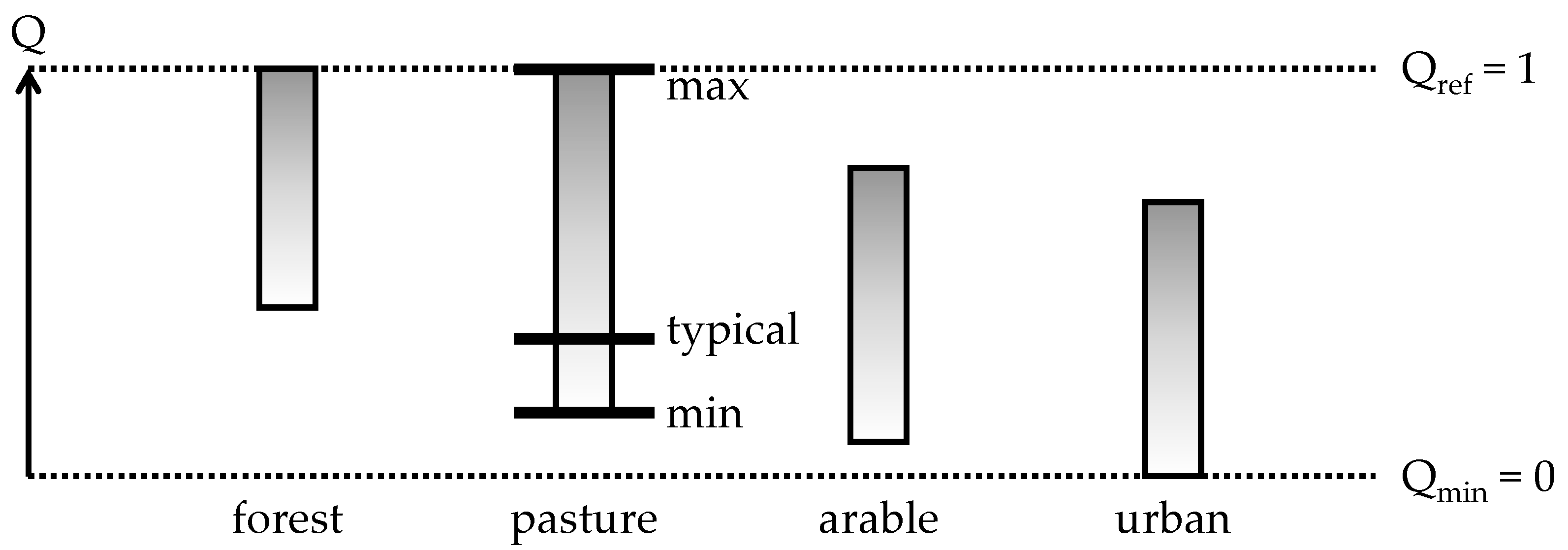
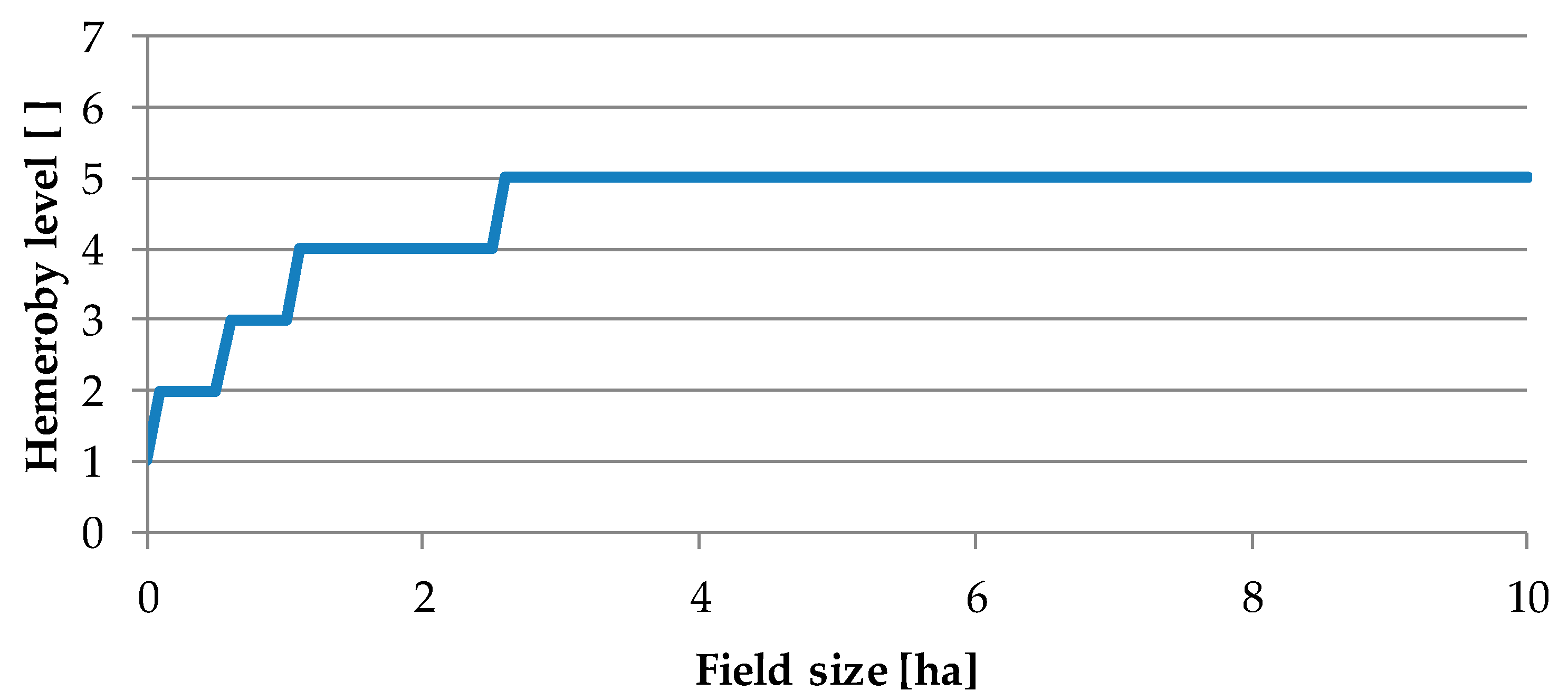
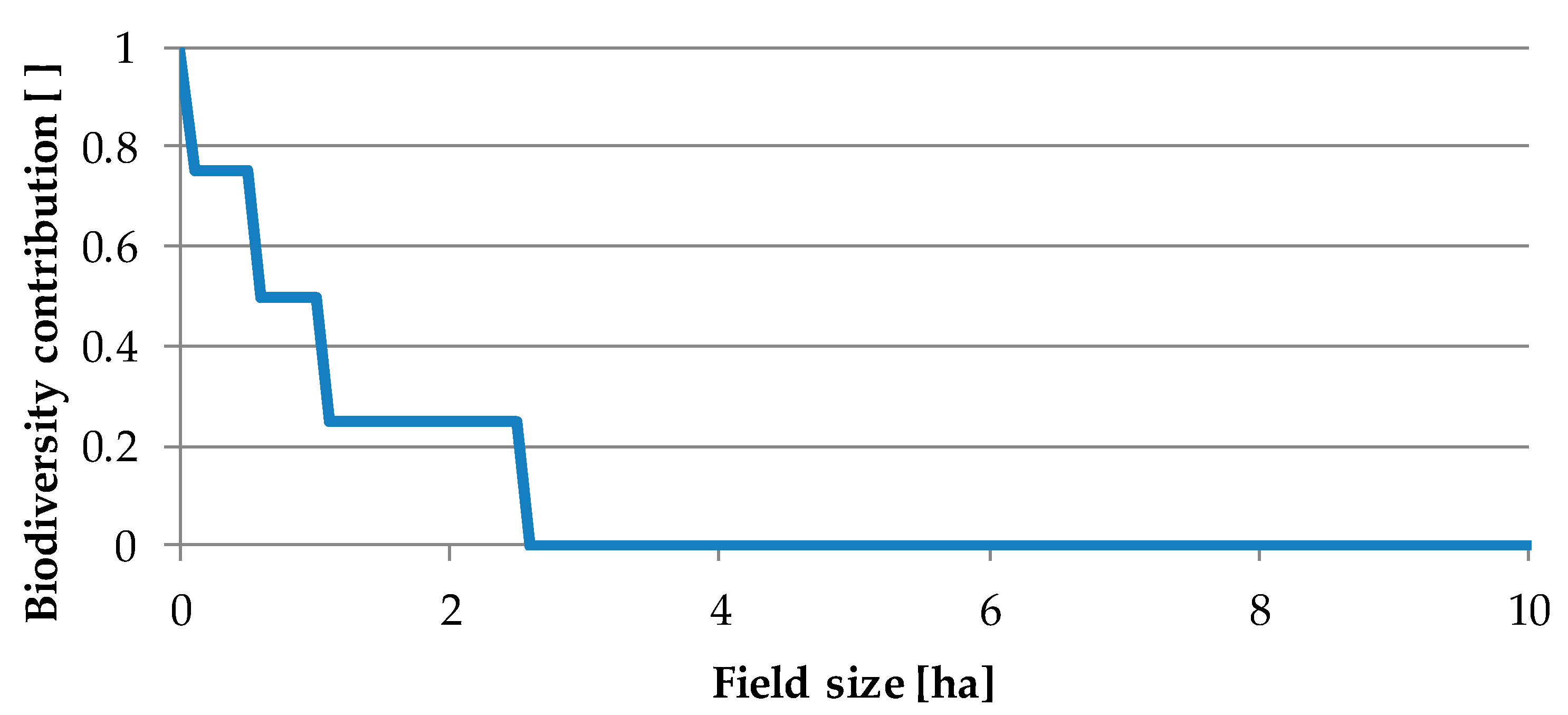
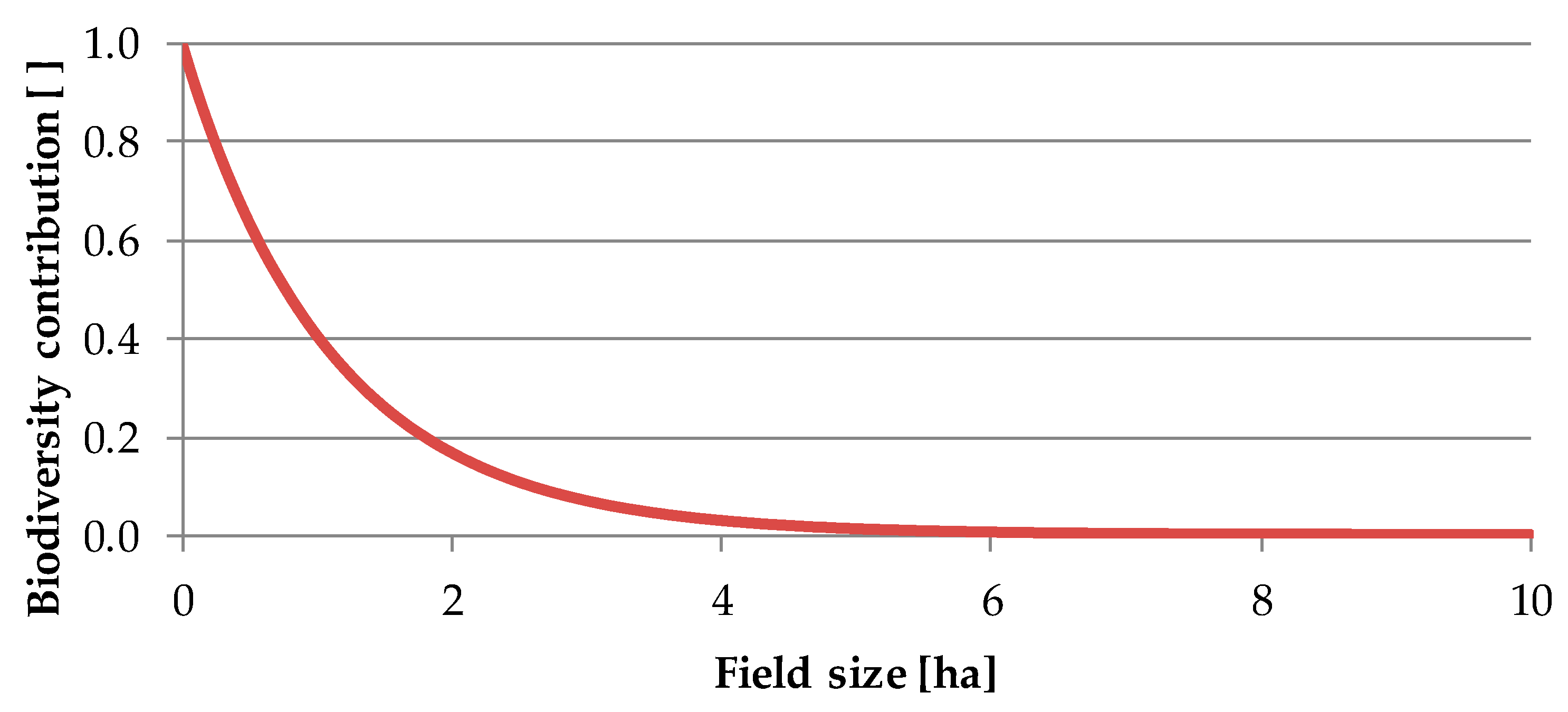
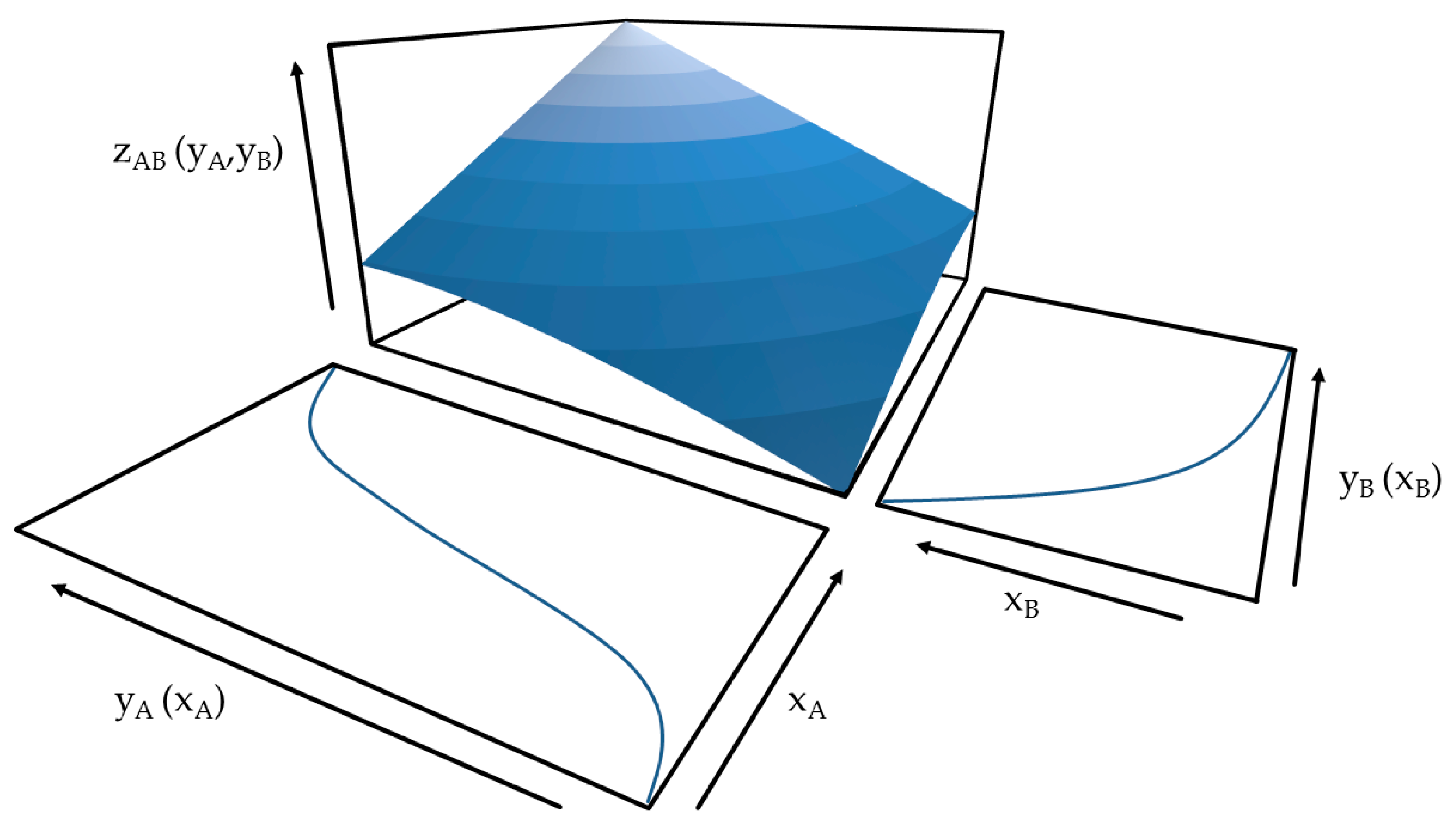
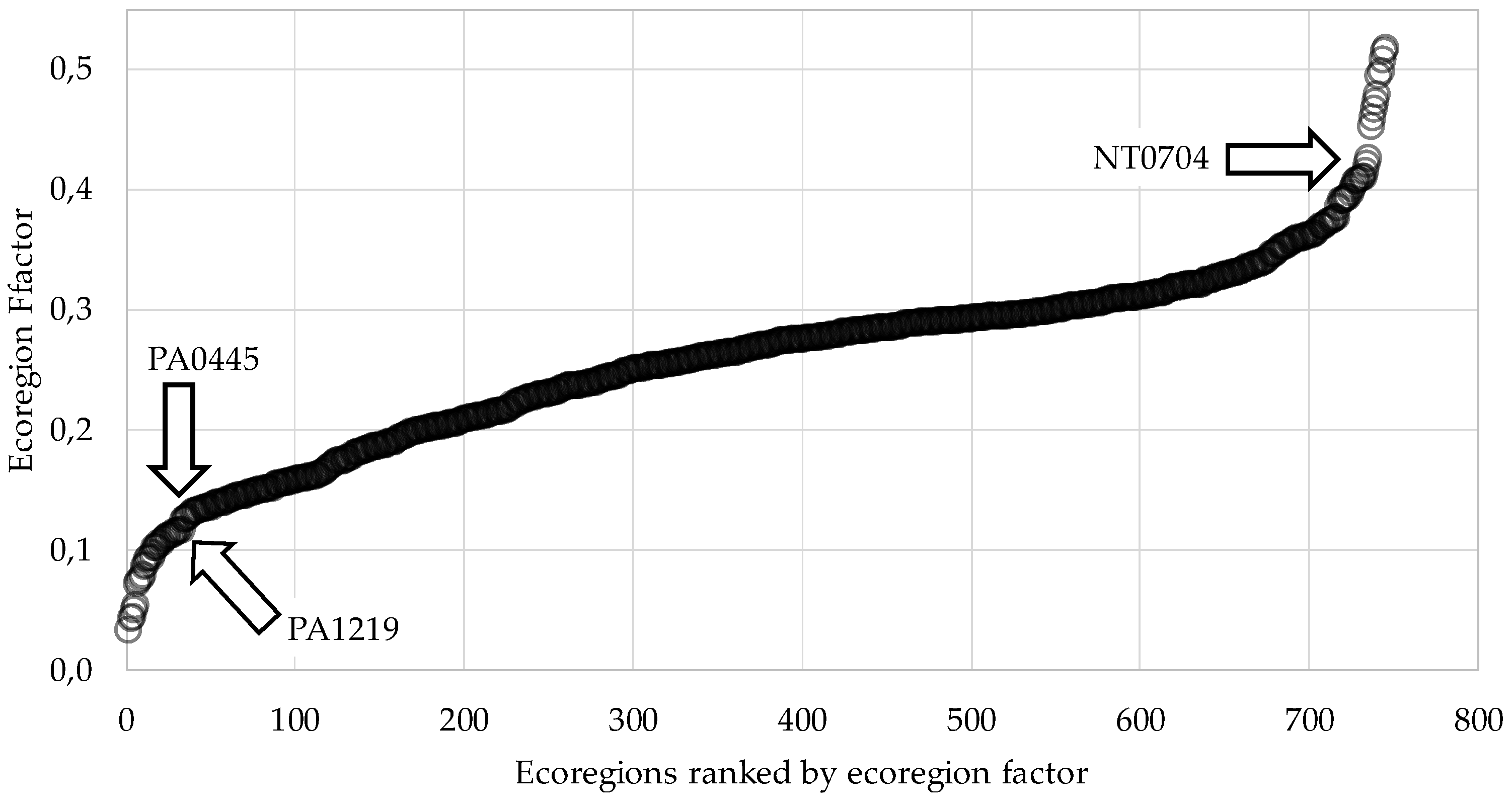
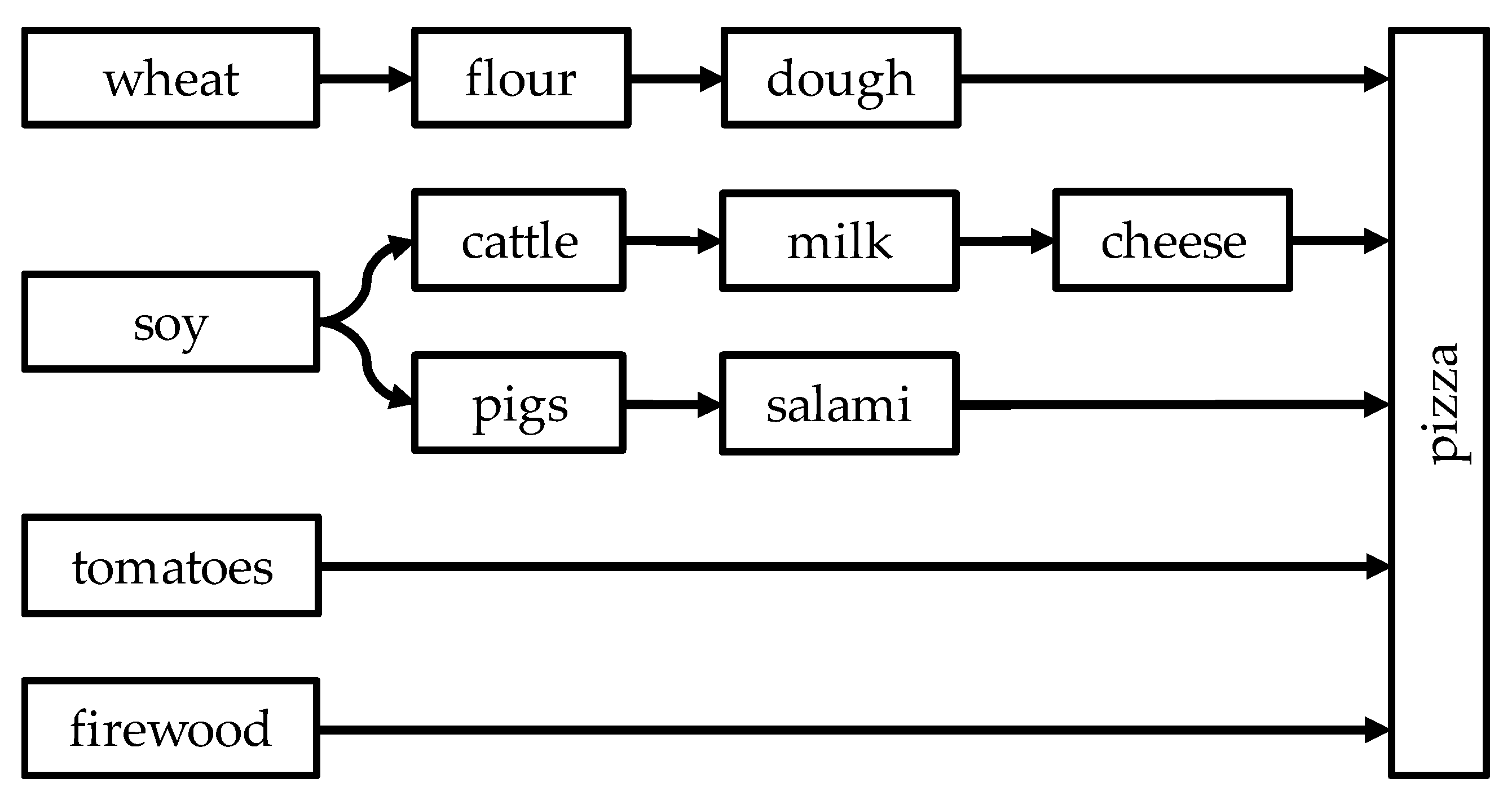
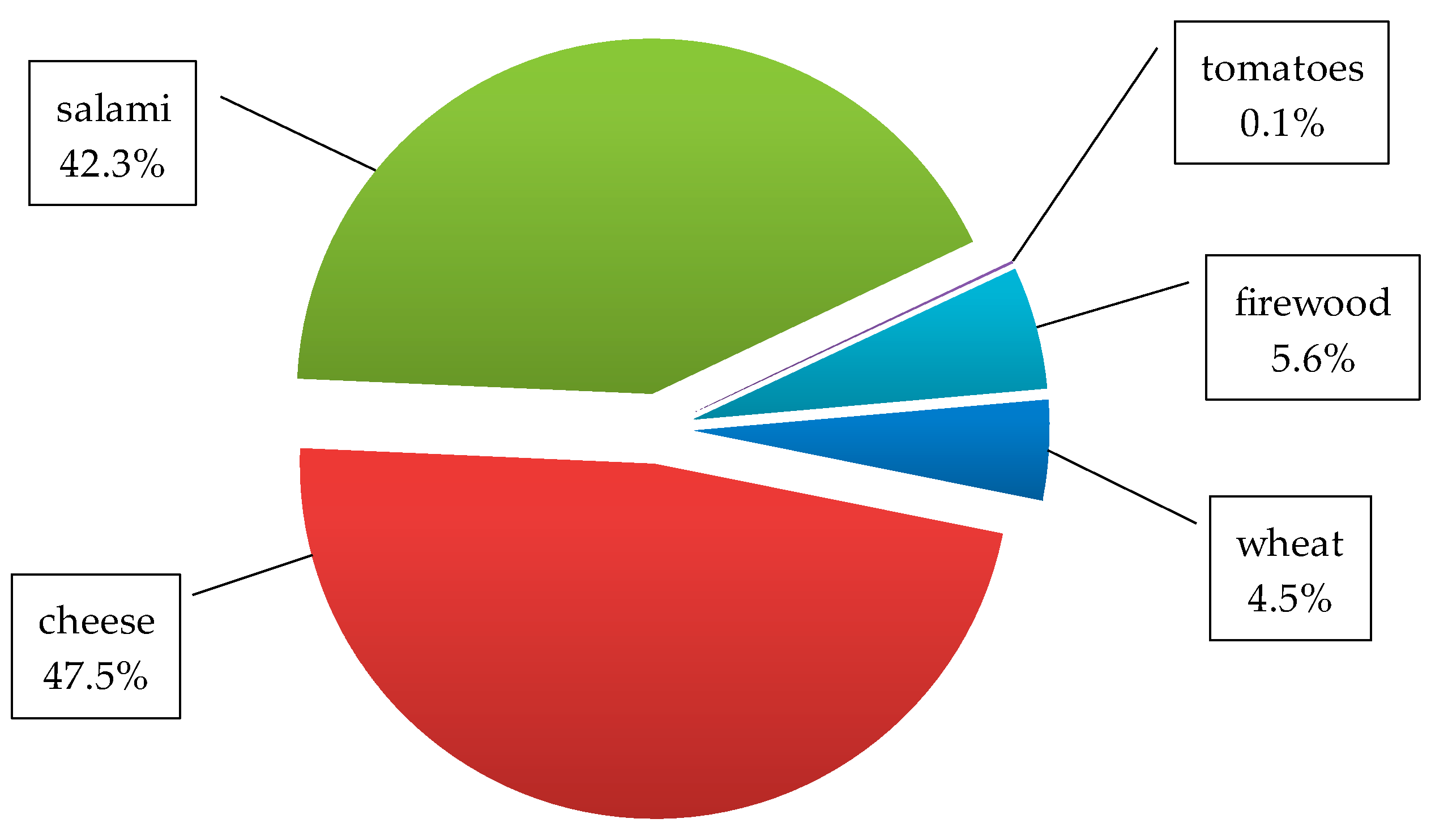
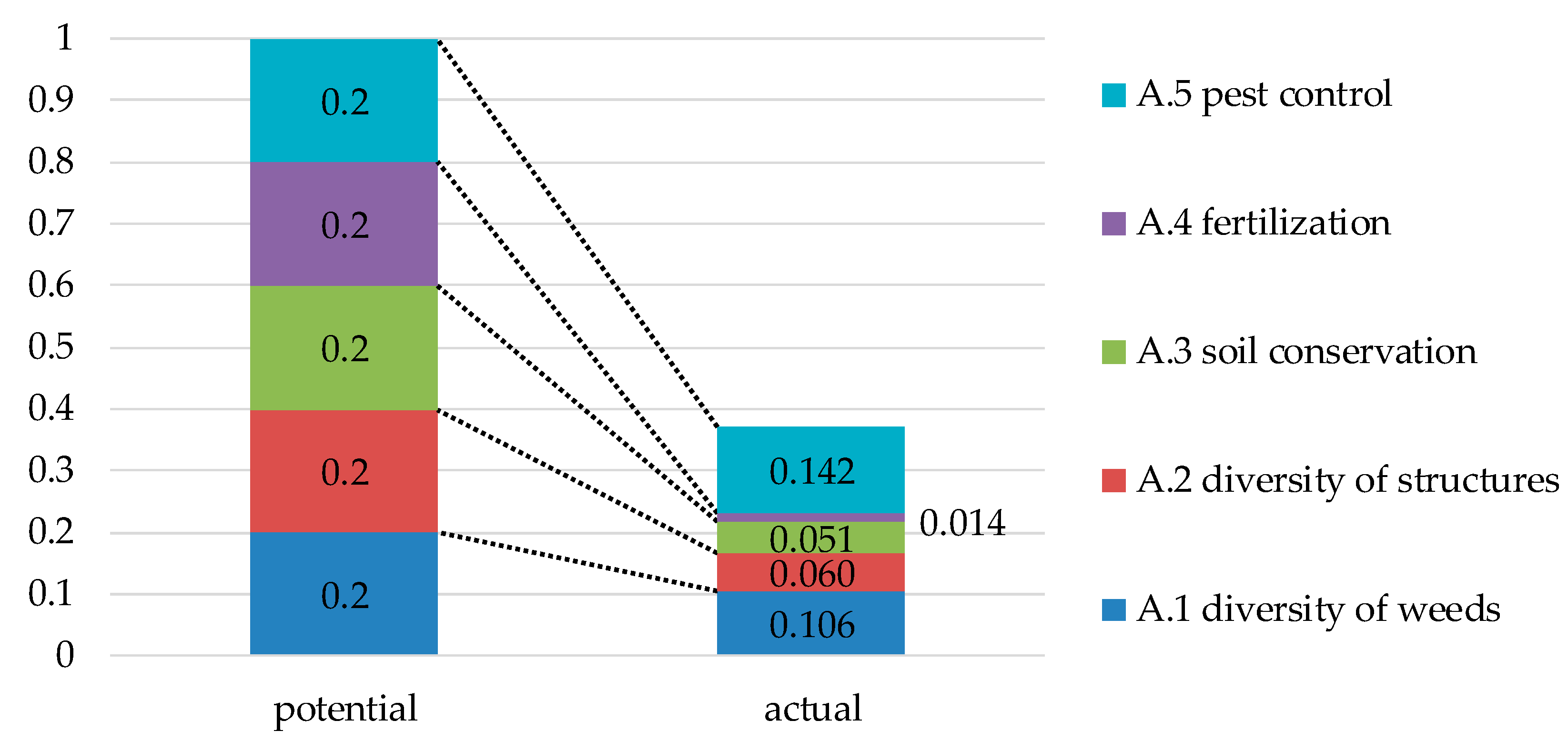
| Ingredient | Quantity per FU | Land Use Class | Ecoregion | Land Use per Ingredient | Land Use per FU |
|---|---|---|---|---|---|
| [m2a/kg] | [m2a/FU] | ||||
| wheat flour | 200 g/FU | agricultural land, typical intensive cultivation | PA0445 (a) | 1.5 | 0.3 |
| cheese | 200 g/FU | agricultural land, monoculture soybean | NT0704 (b) | 4.5 | 0.9 |
| salami | 100 g/FU | agricultural land, monoculture soybean | NT0704 (b) | 8.0 | 0.8 |
| tomatoes | 100 g/FU | greenhouse plantation, highly intensified | PA1219 (c) | 0.05 | 0.005 |
| firewood | 0.002 m3/FU | forest, beech | PA0445 (a) | 1000 | 2.0 |
| Criterion/Parameter | Parameter Value | Criterion Value | Criterion Weight | Weighted Contribution [BVI] | ||
|---|---|---|---|---|---|---|
| A.1 | Diversity of weeds | 0.530 | 0.2 | 0.106 | ||
| A.1.1 | Number of weed species | 0.241 | ||||
| A.1.2 | Existence of rarer species | 0.710 | ||||
| A.2 | Diversity of structures | 0.300 | 0.2 | 0.060 | ||
| A.2.1 | Elements of structure in the area | 0.424 | ||||
| A.2.2 | Size of cuts | 0.000 | ||||
| A.3 | Soil conservation | 0.257 | 0.2 | 0.051 | ||
| A.3.1 | Intensity of soil movement | 0.184 | ||||
| A.3.2 | Ground cover | 0.006 | ||||
| A.3.3 | Crop rotation | 0.931 | ||||
| A.4 | Fertilisation | 0.068 | 0.2 | 0.014 | ||
| A.4.1 | Share of farm manure | 1.000 | ||||
| A.4.2 | Ratio manure vs. slurry | 1.000 | ||||
| A.4.3 | Share of synthetic fertiliser | 0.000 | ||||
| A.4.4 | Share of slurry and synthetic fertiliser beyond growth period | 1.000 | ||||
| A.4.5 | Intensity of fertilisation | 0.136 | ||||
| A.5 | Pest control | 0.708 | 0.2 | 0.142 | ||
| A.5.1 | Input of pesticides | 0.108 | ||||
| A.5.2 | Share of mechanical/biological pest control | 0.995 | ||||
| BVarable | 0.373 | |||||
| BVlocal | 0.353 | |||||
| Ingredient | BVlocal | EF | BVglobal = Q | ΔQ | Land Use per FU | Impact per FU = Land Use * ΔQ |
|---|---|---|---|---|---|---|
| [BVI] | [] | [BVI] | [BVI] | [m2a/FU] | [BVI m2a] | |
| wheat | 0.373 | 0.127 | 0.045 | 0.081 | 0.3 | 0.025 |
| soy/cheese | 0.329 | 0.427 | 0.141 | 0.285 | 0.9 | 0.257 |
| soy/salami | 0.329 | 0.427 | 0.141 | 0.285 | 0.8 | 0.228 |
| tomatoes | 0.000 | 0.110 | 0.000 | 0.110 | 0.005 | 0.001 |
| firewood | 0.821 | 0.127 | 0.112 | 0.015 | 2.0 | 0.030 |
| total | 0.540 | |||||
© 2019 by the authors. Licensee MDPI, Basel, Switzerland. This article is an open access article distributed under the terms and conditions of the Creative Commons Attribution (CC BY) license (http://creativecommons.org/licenses/by/4.0/).
Share and Cite
Lindner, J.P.; Fehrenbach, H.; Winter, L.; Bloemer, J.; Knuepffer, E. Valuing Biodiversity in Life Cycle Impact Assessment. Sustainability 2019, 11, 5628. https://doi.org/10.3390/su11205628
Lindner JP, Fehrenbach H, Winter L, Bloemer J, Knuepffer E. Valuing Biodiversity in Life Cycle Impact Assessment. Sustainability. 2019; 11(20):5628. https://doi.org/10.3390/su11205628
Chicago/Turabian StyleLindner, Jan Paul, Horst Fehrenbach, Lisa Winter, Judith Bloemer, and Eva Knuepffer. 2019. "Valuing Biodiversity in Life Cycle Impact Assessment" Sustainability 11, no. 20: 5628. https://doi.org/10.3390/su11205628
APA StyleLindner, J. P., Fehrenbach, H., Winter, L., Bloemer, J., & Knuepffer, E. (2019). Valuing Biodiversity in Life Cycle Impact Assessment. Sustainability, 11(20), 5628. https://doi.org/10.3390/su11205628




